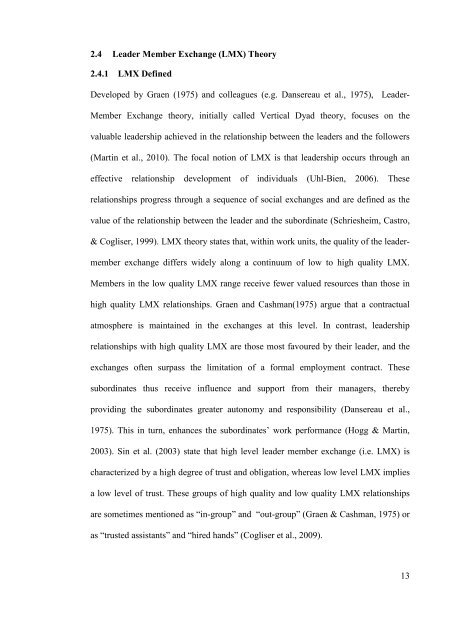View/Open
View/Open
View/Open
You also want an ePaper? Increase the reach of your titles
YUMPU automatically turns print PDFs into web optimized ePapers that Google loves.
2.4 Leader Member Exchange (LMX) Theory<br />
2.4.1 LMX Defined<br />
Developed by Graen (1975) and colleagues (e.g. Dansereau et al., 1975), Leader-<br />
Member Exchange theory, initially called Vertical Dyad theory, focuses on the<br />
valuable leadership achieved in the relationship between the leaders and the followers<br />
(Martin et al., 2010). The focal notion of LMX is that leadership occurs through an<br />
effective relationship development of individuals (Uhl-Bien, 2006). These<br />
relationships progress through a sequence of social exchanges and are defined as the<br />
value of the relationship between the leader and the subordinate (Schriesheim, Castro,<br />
& Cogliser, 1999). LMX theory states that, within work units, the quality of the leader-<br />
member exchange differs widely along a continuum of low to high quality LMX.<br />
Members in the low quality LMX range receive fewer valued resources than those in<br />
high quality LMX relationships. Graen and Cashman(1975) argue that a contractual<br />
atmosphere is maintained in the exchanges at this level. In contrast, leadership<br />
relationships with high quality LMX are those most favoured by their leader, and the<br />
exchanges often surpass the limitation of a formal employment contract. These<br />
subordinates thus receive influence and support from their managers, thereby<br />
providing the subordinates greater autonomy and responsibility (Dansereau et al.,<br />
1975). This in turn, enhances the subordinates’ work performance (Hogg & Martin,<br />
2003). Sin et al. (2003) state that high level leader member exchange (i.e. LMX) is<br />
characterized by a high degree of trust and obligation, whereas low level LMX implies<br />
a low level of trust. These groups of high quality and low quality LMX relationships<br />
are sometimes mentioned as “in-group” and “out-group” (Graen & Cashman, 1975) or<br />
as “trusted assistants” and “hired hands” (Cogliser et al., 2009).<br />
13

















